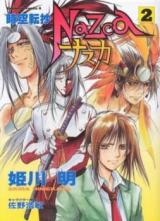First of all, a note on availability: Storm in Heaven have scanlated ch1-3a and you can easily find them on Google, but on their official website they say they're waiting to finish a HQ version before hosting it. These first scanlations are very good in image quality, but the translation is a little bit literal and awkward in parts. I've read much worse though; SiH are clearly perfectionists. It's a little annoying as there are only two volumes; I'd rather they just keep going and release the whole thing.
I saw the first three episodes of the more well-known DVD anime-Nazca before I read this manga, so I'll compare them.
The story of Nazca is original and engrossing. Kyoji, an ex-delinquent and talented kendo student, discovers that both he and his shishou, Masanari, are reincarnations of ancient Inca warriors who fought each other in a civil war. They are forced to battle both because of destiny and out of a shared love for Masanari's fiancee, Kiritake. The series is about the conflict between individual desire and fate; Kyoji deeply respects Masanari and would rather not destroy him. The story is told fairly well, and better in the manga than in the anime. It's more detailed, it makes more sense and it's got more substance. It's nice to see a fantasy work about a historical empire that rarely gets that treatment, rather than another one about Edo Japan or ISO Standard Medieval Europe.
The characters, and their interactions, are especially well-treated - and so vastly better than in the anime. The protagonists are given much-needed development; Kyoji is a likable and kick-ass teen with a difficult past who looks up to his shishou. Masanari is a serious and awesome omnidisciplinary who strains his relationship with the woman with he loves; he has a slightly difficult past too. The characters are more complex and interesting; even their reactions and facial expressions are multifaceted by shounen standards. Kyoji has a greater understanding of the situation he's been thrust into and his motivations are more fleshed-out.
Also, their relationship and dialogue has a recurring homosexual undertone. (Kiritake and Kyoji's schoolfriends also comment on it.) It would take too much space to list the hints, but they're there; I wasn't surprised to learn that the creators of Nazca were women. Even this element is also treated better than in the anime! It's more sustained, but subtler. Straight male readers: please keep an open mind and read this anyway.
The dialogue in the manga is generally superior to the anime's; even despite the translation issues, you can sense a superior intelligence behind it. You learn more from it and it's wittier.
Now, onto the art. It's perfectly professional and well-done. The backgrounds, historical features and stylistic choices show some originality. The artwork isn't sullied by non-matching CGI and transfer artefacts, as the anime is. However, compared to the anime, it's more shounen and less adult, which normally would turn me off, and I do feel this series deserves to be treated more seriously. The characters of Shiogami, his girlfriend, the other students and the delinquents are actually better-designed than in the anime, and Masanari is about the same (and almost as bishounen), but Kyoji and Kiritake I'm not so sure about. They are still at least OK, just not stunning.
So, overall, this manga is worth reading in its own right, and it makes much better use of its premise than the anime does, which is a wasted opportunity. It deserves to be better known, and it won't cost you anything to try it, so please dip your toe into the first volume of Nazca.
UPDATE: The whole thing has been released. This review only covers the old ch1-3, which are inferior to SiH's new, complete translation.





